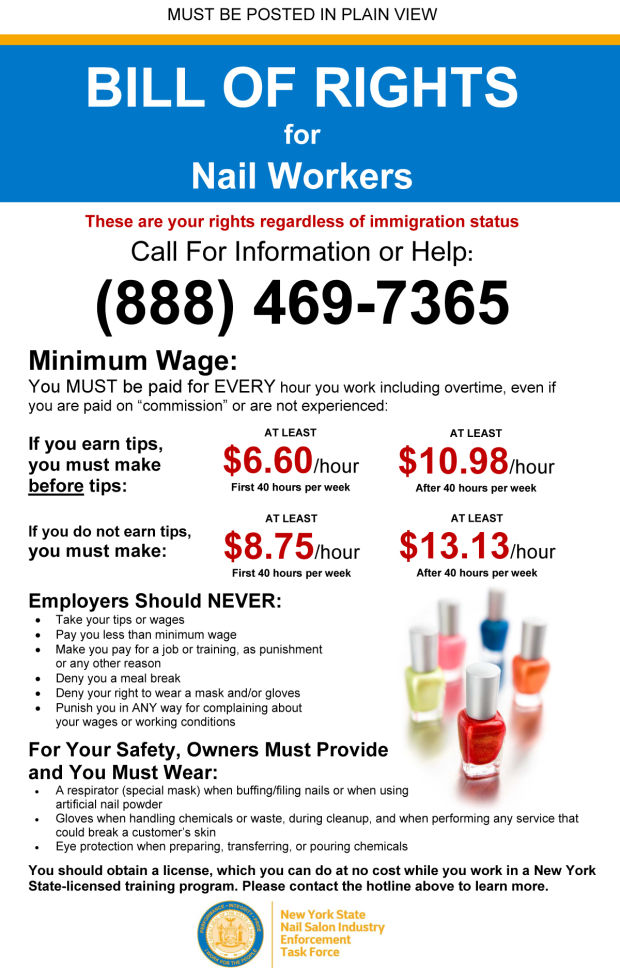New York Gov. Andrew Cuomo has instilled several measures to protect nail salon workers against mistreatment by owners across the state. Following the discovery of widespread abuse in the industry revealed in a recent New York Times series, the governor has taken immediate action to quell this fiasco. On May 29, Cuomo established a Bill of Rights for Nail Salon Workers and unveiled a plan to facilitate customer intervention. This includes the distribution of pocket cards that state the top 5 things to ask when entering a nail salon.
Workers’ Bill of Rights
Effective immediately, NY nail salons must post a manicurists’ bill of rights in clear sight to both employees and customers. These placards include the following:
- Task Force hotline for complaints or reports of violations
- minimum wage with and without tips (including overtime rates)
- a list of prohibited actions for nail salon employers
- a list of protective equipment an owner must provide his or her employees
The bill of rights will be available in 10 different languages, including Chinese and Korean. The bill of rights also clearly establishes that the rights are pertinent for all nail salon workers regardless of their immigration status. This is important information for all the workers who feel trapped without proper documentation. Nail salon owners who fail to post these placards in plain view will be subject to penalties. For perspective on what these placards look like, click here.
Pocket Cards
In an effort to increase customer involvement, Cuomo and his task force have created pocket cards with a list of 5 questions customers are encouraged to ask when entering nail salons. These questions are:
- Are workers paid at least the minimum wage and overtime?
- Is appropriate protective equipment (respirator mask, gloves, eye protection) provided to workers and used?
- Is there adequate ventilation (no strong chemical odors)
- Is the salon business license posted in plain view?
- Is the Nail Salon Workers’ Bill of Rights posted in plain view?
These cards also include the hotline for the nail salon task force. It remains to be seen if nail salon customers will actually ask these questions, but the state’s hope is for customers to solely patronize salons acting in accordance with the law. If customers do not give their business to corrupt salons, they will have no choice but to shut down. Customer intervention plus increased enforcement of the law by the state should help to reduce the abusive mistreatment of nail salon workers across the state. Customers that wish to download the pocket card may do so at www.ny.gov/programs/nail-salon-safety-what-you-need-know.
Officials are also planning to distribute an information card to increase consumer awareness. Photo courtesy of the New York Times.
In the Works
While the bill of rights and pocket cards are immediately taking effect, there is additional legislation in the works to improve the health and safety standards in the nail salon industry. Public Advocate Letitia James is sponsoring the Nail Salon Health and Safety Bill (Intro 304), which attacks several loosely enforced areas of the industry in New York. Targeted measures in this bill include:
- prohibition of products with certain chemicals
- improvement of air quality in salons
- implementation of procedures to limit spread of communicable diseases
- substitution of less hazardous alternatives for current products
- requirement of salons in NYC to register with City Department of Health
- expansion of outreach programs for health and safety of industry
James also published a policy report regarding the safety of nail salons late last year. It includes research concerning customer and employee safety issues, the best practices in the nail salon industry, and recommendations. Additional legislation has been introduced by Gov. Cuomo in an effort to implement harsher penalties and require trainees in the nail salon industry to obtain a certificate of registration before applying for a license.
While this legislation will take time to be enacted, the task force is taking immediate action to raise awareness among consumers and salon workers alike. On May 21, Mayor Bill de Blasio sponsored an event during which hundreds of volunteers visited approximately 1,000 nail salons in NYC and provided information about wages, safety and other issues to employees. The goal is to equip nail salon workers and customers with the necessary knowledge to promote and ensure compliance from owners in the industry.

